Galvanic Treatments
Galvanic beauty treatments – which includes electrolysis, iontophoresis and desincrustation – have been standard salon practices for a long time. The earliest, electrolysis, made the switch from a medical procedure to a beauty treatment in the 1880s. Iontophoresis, another medical treatment known under a variety of names, could also be found in some beauty salons by 1903 at the latest.
Types of electrical current
Late nineteenth-century doctors classified their electrical treatments according to the ‘type’ of electric current being used. These were categorised according to how the current was produced, with each form named after a famous scientist – i.e., franklinic, galvanic and faradic. Two of these, galvanic and faradic found their way into Beauty Culture.
See also: Faradic Treatments
Galvanic currents
Galvanic electricity was named after Luigi Galvani, the discoverer of ‘animal electricity’. It referred to electric currents produced by chemical action so batteries and the electric current they generated were described as galvanic.
Batteries have a fixed polarity – one pole, terminal or electrode is positive, the other negative – so the electrical current they produce only flows in one direction, with electrons moving from the negative to the positive pole. It is unidirectional, what we would now call a direct current (D.C.).
Over time, scientific definitions changed, and the type of current, rather than the source, became the determining factor in how the current was named. At first, all forms of direct current, no matter how they were produced – whether by battery or dynamo – were known as galvanic but later, the term ‘galvanic’ was abandoned by scientists in favour of ‘direct’. However, the beauty industry stuck with galvanic and still uses it today.
Uses of galvanic (direct) currents
Early medical treatments used the electromagnetic, thermal and chemical effects of galvanic (direct) currents but only the chemical effects proved to be of major importance in the long run.
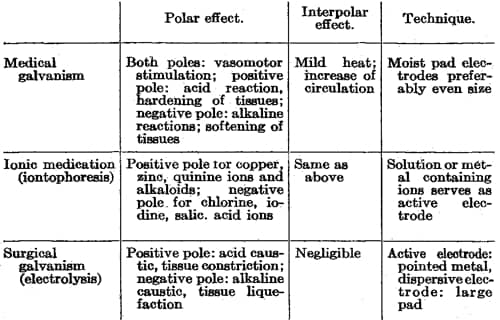
Above: The chemical effects of a galvanic current used in medical practice. Polar effects occur at the electrodes, interpolar effects such as heating occur between the electrodes (Kovacs, 1935).
The same applied to beauty treatments. Some warmth may be produced during a galvanic treatment but beauty treatments that use galvanic (direct) currents rely primarily on their chemical effects.
The action of the galvanic current is always chemical; hence it is often called the “chemical current.” It is also called the uni-directional current, because it always flows continuously in the same direction under any one set of conditions.
(Wall, 1946, p. 270)
Chemical effects
As mentioned previously, galvanic (direct) currents have a fixed polarity, so when the current comes into contact with body tissues the positive pole (anode) produces acid while the negative pole (cathode) generates an alkali. This occurs because body fluids naturally contain dissolved salts (electrolytes) which can be effected by electrical charges.
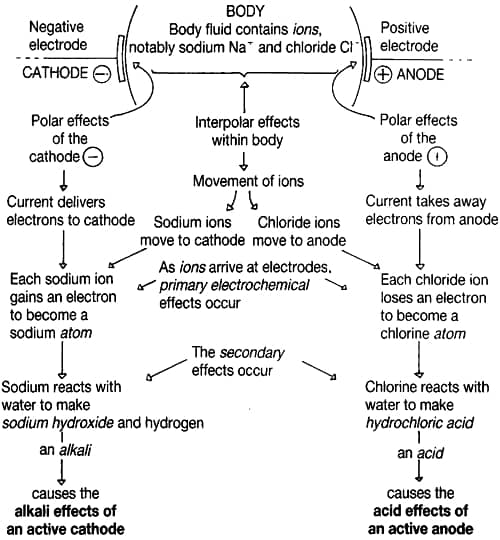
Above: The chemical effects produced by a galvanic (direct) current at the positive and negative electrodes (Simmons, 1989).
The medical profession credited the acid with having a hardening effect on the tissue while the alkali was said to be softening.
Since the positive pole creates acid, as a natural consequence there will be a contraction of all pores, tissues, blood vessels and glands with which it comes in contact. … Because the blood vessels grow smaller the blood is forced away from the surface being treated … with a sedative effect as the result, thereby decreasing pain. Since acid is decidedly destructive to bacteria in any form, the positive pole can also be termed germicidal.
Let us now consider the negative pole. … [I]t is alkaline in reaction and exactly oppositional to the positive. Therefore upon its application we find that a relaxation of the pores results, a softening of the tissue, an expansion of the blood vessels … an increased supply of blood which results in a slight irritation to the surface being treated and a resultant stimulation.(Stingley, 1939, pp. 35-36)
Polarity test
As the positive and negative electrodes produced different chemical effects, ensuring the polarity of the electrode was correct was an important safety consideration before any galvanic beauty treatment was commenced.
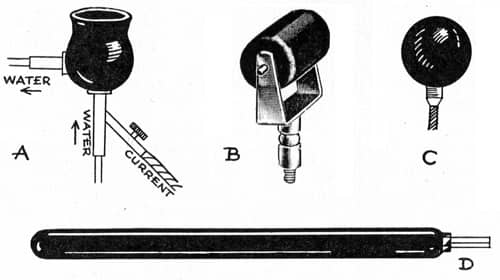
Above: Electrodes used in early galvanic treatments. A. Electrolytic Cup. B. Carbon Roller. D. Carbon Ball. D. Carbon Cylinder.
Determining the polarity of an electrode could be done in a number of ways but two common methods were the ‘Bubble Test’ and the ‘Litmus Test’.
Bubble Test: The electrodes are dipped into a glass of salty water. Bubbles may appear on both electrodes when the current is switched on but more bubbles will be produced at the negative electrode (cathode).
Litmus Test: Either litmus paper or universal indicator can be used. These will turn red at the positive electrode (anode) and blue at the negative electrode (cathode).
Treatments
As mentioned earlier, there are three main galvanic (D.C.) treatments currently available in salons: electrolysis, iontophoresis and desincrustation.
Electrolysis
Electrolysis (galvanic epilation) relies on the ability of a galvanic (direct) current to produce sodium hydroxide, (caustic soda) via a negatively-charged, needle electrode. This is used to kill the germinating cells in the hair follicle and stop regrowth. Although permanent hair removal by electrolysis only became a medical procedure from 1875, doctors had used electrolysis needles to treat other skin growths much earlier than this. The practice, known as surgical electrolysis, was used on growths such as birthmarks, warts, moles and cancers.
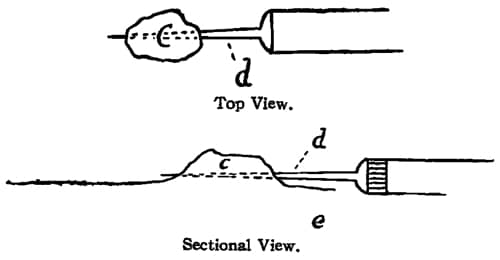
Above: Electrolysis of a wart or mole. c: Portion of growth raised above the surface of the skin. d: Sharp needle in holder piercing the growth. e: Epidermis. (Modified from Strong, 1908, p. 44).
Early beauty salons also adopted surgical electrolysis and used their electrolysis equipment to remove an assortment of skin blemishes such as moles, warts and spider veins (telangiectasia). Most operators today would not treat moles or warts but electrolysis treatments are still being used in salons to remove some skin blemishes such as spider veins.
See also: Electrolysis
Ionic medication (Iontophoresis)
Beauty salons also used their galvanic equipment for another medical practice, pushing ions – water-soluble substances that have either a positive or negative charge – through the surface of the skin. Known under a variety of names – such as cataphoresis and phoresis – the practice was used in early salons to administer pain relievers – such as cocaine – during electrolysis, to help improve the action of bleaching treatments, to apply sulphur compounds on acne-prone skin, and to reinforce the action of astringents, toners and cleansing lotions.
The medical profession’s high hopes for ionic medication (iontophoresis) proved to be ill-founded. Despite the limited scientific evidence that the practice had any worthwhile benefits, some beauty businesses, like Guinot, embraced the technology and, after the Second World War, began manufacturing ampoules for use in iontophoretic beauty treatments.
There are now many examples of these products on the market made with a wide variety of ingredients such as vitamins, minerals, plant extracts, soluble collagen and hyaluronic acid. Some are recommended for facials, others for body treatments with the later being used primarily for dealing with cellulite. In many cases very little information is given about the composition of the ampoules except for the procedure in which they are to be used and the electrode – positive or negative – required.
See also: Iontophoresis
Desincrustation
Desincrustation was developed in France by the Société P.A.B. in the early 1930s. Like electrolysis, it uses a galvanic (direct) current to produce sodium hydroxide at the negative electrode. However, as the sodium hydroxide is spread over the surface of the skin it only softens it. This was said to help remove surface keratinocytes and loosen hard plugs of sebum. The treatment was therefore commonly employed in a facial cleansing routine before extractions.
See also: Desincrustation
A similar idea was the basis for an earlier American device called the Electrolytic Cup which combined an alkali produced by a galvanic (direct) current with a water-generated vacuum suction.
See also: Electrolytic Cup
Updated: 14th January 2020
Sources
Blood, I. H. (1928). The cosmetiste: A handbook on cosmetology with special reference to the employment of electricity in the care of the hair, scalp, and face at the direction and under the supervision of W. M. Meyer (6th ed.). Chicago, IL: The W. M. Meyer Co.
Gottschalk, F. B. (1904). Practical electro-therapeutics. Chicago, IL: T. Eisele.
The science of beautistry. Official textbook approved for use in all the national schools of cosmeticians affiliated with Marinello. (1932). New York: The National School of Cosmeticians, Inc.
McIntosh Battery and Optical Company. (1903). The skin. Its care and treatment. Chicago: Author.
W. M. Meyer Co. (1936). The cosmetiste: A textbook on cosmetology with special reference to the employment of electricity in the care of the hair, scalp, face, and hands, also permanent waving and hair curling (9th ed.). Chicago, IL: Author.
Moler, A. B. (1905). The manual on barbering, hairdressing, manicuring, facial massage, electrolysis and chiropody as taught in the Moler system of colleges.
Overall, G. W. (1890). Practical electricity in medicine and surgery. Memphis, TN: Press of Memphis Printing Company.
Morris, J. (1987). Beauty therapist’s handbook. London: B. T. Banford Limited.
Simmons. J. V. (1989). Science and the beauty business. Volume 2. The beauty salon and its equipment. London: The Macmillan Press Ltd.
Stingley, G. (1939). Electricity manual for beauty culture (10th revised ed.). Chicago, IL: Author.
Stingley, G. (1957). Electricity manual for beauty culture (15th ed.). Maywood, CA: Author.
Strong, F. F. (1908). Essentials of modern electro-therapeutics: An elementary text-book on the scientific therapeutic use of electricity and radiant energy. New York: Rebman Company.
Wall, F. E. (1946). The principles and practice of beauty culture (2nd ed.). New York: Keystone Publications.

Luigi Galvani [1737-1798].
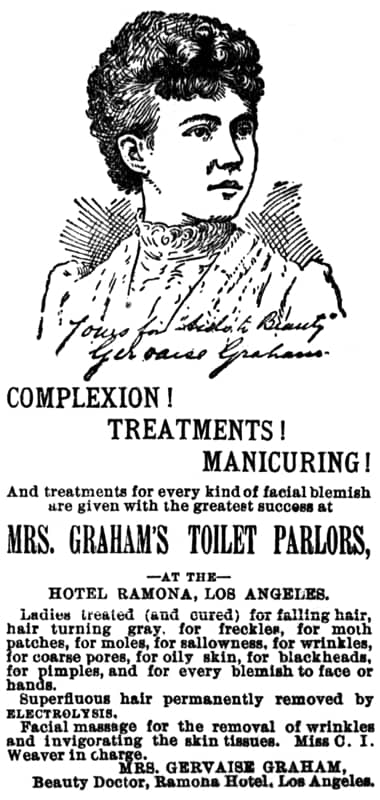
1892 Mrs. Graham’s Toilet Parlours advertising hair permanently removed by electrolysis.
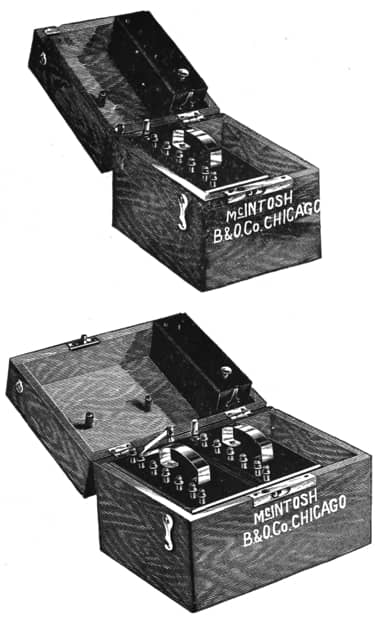
1895 McIntosh Galvanic Batteries suitable for use in a doctors surgery or beauty salon.
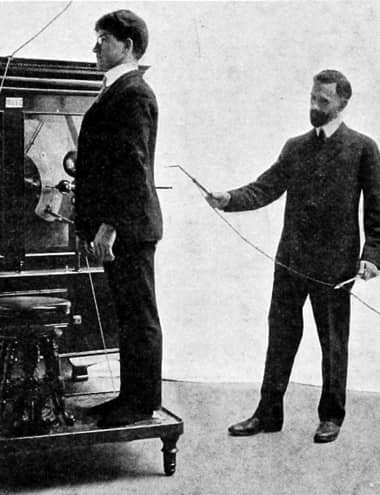
1904 A doctor administering franklinic (static) electricity – named after Benjamin Franklin [1706-1790]. This ‘type’ of medical electricity was not used beauty salons.
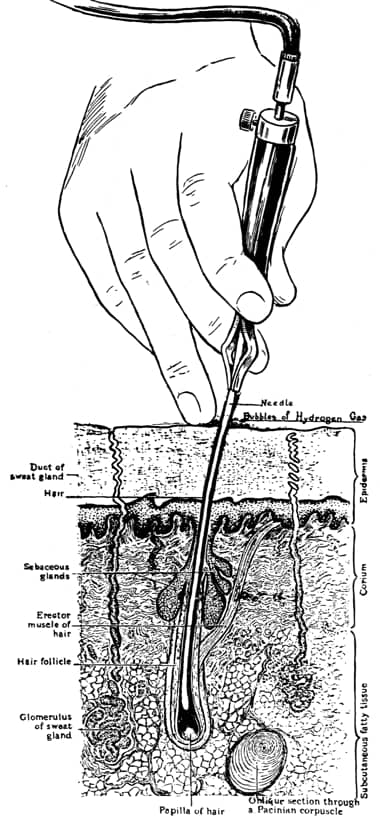
Diagran showing an electrolysis needle inserted into a hair follicle.
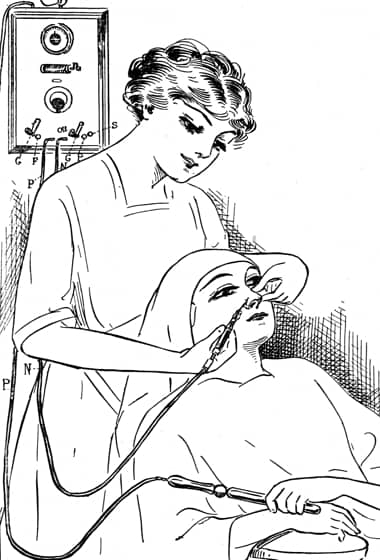
Treating telangiectasia (enlarged capillaries or spider veins) using electrolysis.
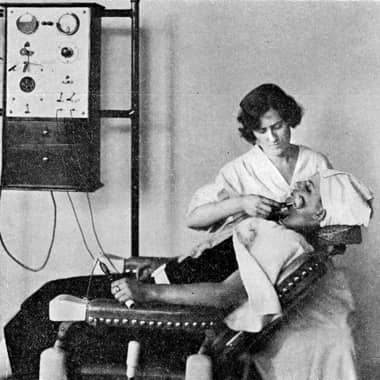
1927 Cataphoresis using a roller electrode.
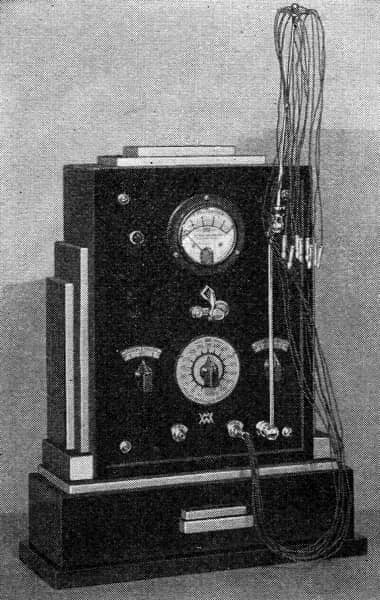
1936 Galvanic and Faradic Wall Plate. This could power galvanic and faradic treatments and had leads for multiple needle electrolysis.
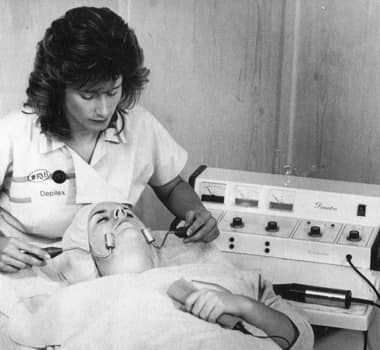
Galvanic treatment (iontophoresis) using roller electrodes. Although the equipment is modern, the practice is essentially the same as the earlier cataphoresis treatment (Morris, 1987).
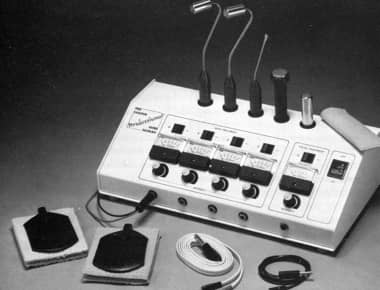
Galvanic unit for facial for body treatments (Morris, 1987).
